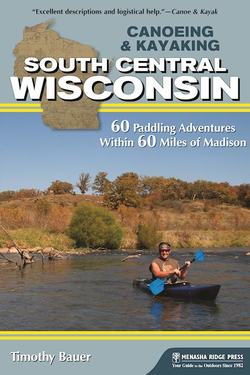Читать книгу Canoeing & Kayaking South Central Wisconsin - Timothy Bauer - Страница 12
ОглавлениеIntroduction
YOU ARE HOLDING IN YOUR HANDS a book borne of an indefatigable love for paddling in general and in Wisconsin specifically. Despite the state’s long winters of frozen water, short exclamations of spring thaw and autumn foliage, and summers ridden with mosquitoes and ticks, Wisconsin is blessed with many gorgeous streams and lakes. Our state has further benefited from forward-thinking lawmakers who years ago set in place commendable policies granting virtually unlimited public access to all navigable waters. As a result, plenty of guides have expounded upon the more popular paddling trips our state offers. This book strives to be both a part of that guidebook tradition as well as apart from it by detailing trip ideas for a surprisingly rich paddling territory that has previously been forgotten or ignored.
The premise of this book is simple: 60 trips within 60 miles of Madison. Why Madison? For one, it’s where I live, plus it’s the state’s capital. For another, it’s centrally located in southern Wisconsin, which, while not as abundant as the state’s northern portion in opportunities to “get away from it all,” is nonetheless rich in outdoor offerings—they just take a little more time and inclination to find. In addition to convenience, Madison provides a tidy geological demarcation: Everything to the east was glaciated in the last ice age some 13,000 years ago, while everything to the west wasn’t. With Madison at the center, the 60-mile circumference extends to Platteville to the southwest, Horicon to the northeast, Lake Geneva to the southeast, and Wonewoc to the northwest.
Purists might disregard the premise of a paddling guidebook whose target area is south central Wisconsin, due to the urban sprawl associated with the Madison and Milwaukee suburbs, not to mention the agriculture in between. Yet not everyone has the time or means to spend a week up in the Boundary Waters or even Sylvania. Not everyone can or wants to spend a week down the Flambeau River. Wilderness areas are spectacular, to be sure, but they’re often impractical for most of us who seek some communion with the outdoors on a more regular basis. This book is intended for folks who can’t feasibly work in those types of adventures with regularity but nonetheless yearn for paddling excursions.
Nature is all around us; we do not need to venture far to find it. Being “in touch with nature” should not be the exclusive privilege of those with the means to leave their own homes in hopes of some kind of exotic escapism. Nature is outside and outdoors, you bet, but not necessarily “out there” in some metaphysical landscape off the grid requiring a long drive and a full tank of gas. My backyard doesn’t look like the backdrop to an REI ad, but I can drive 20 minutes and find a Class I trout stream with Class I rapids surrounded by an ancient valley of glacial hills—and still make it home in time for the Packers game.
This book primarily offers single-day outings, with the exception of a few trips that require a one-night minimum campout on a river (or two nights, depending on your pace and water levels). The landscapes these rivers and creeks course through are as varied as the streams themselves: Driftless cliffs and glacier-deposited drumlin hills, gentle prairies and wind-swept marshes, oak savannas and floodplain swamps, just to name a few. You won’t see bears or wolves down here, but otters and yellow-crowned night herons are good bets.
No trip in this book requires expert skills, though I have distinguished those who are new to paddling (“Beginners”) from those who have many miles under their belts (“Experienced”). Because of the broad range of this guide, some of the trips here are bound to disappoint one kind of paddler as “not enough” while intimidating another paddler as “too much.” Duck Creek in Columbia County might be too dull for some but is perfect for beginners, kids, and bird-watchers. The Little Platte River in Grant County is a jubilation for experienced paddlers but too dangerous for newbies.
Just the same, it is my hope that this book inspires an appreciation for our local landscape through water, whatever one’s paddling experience.
